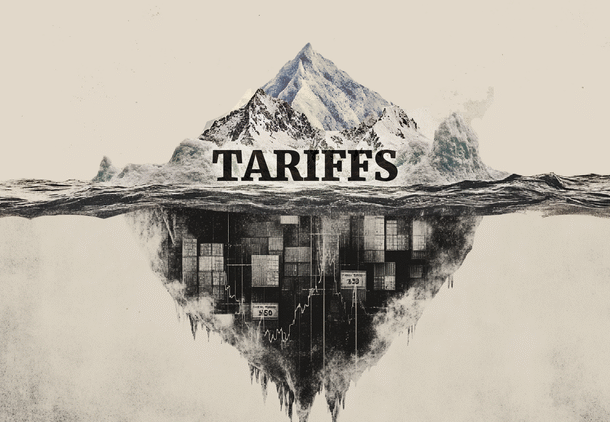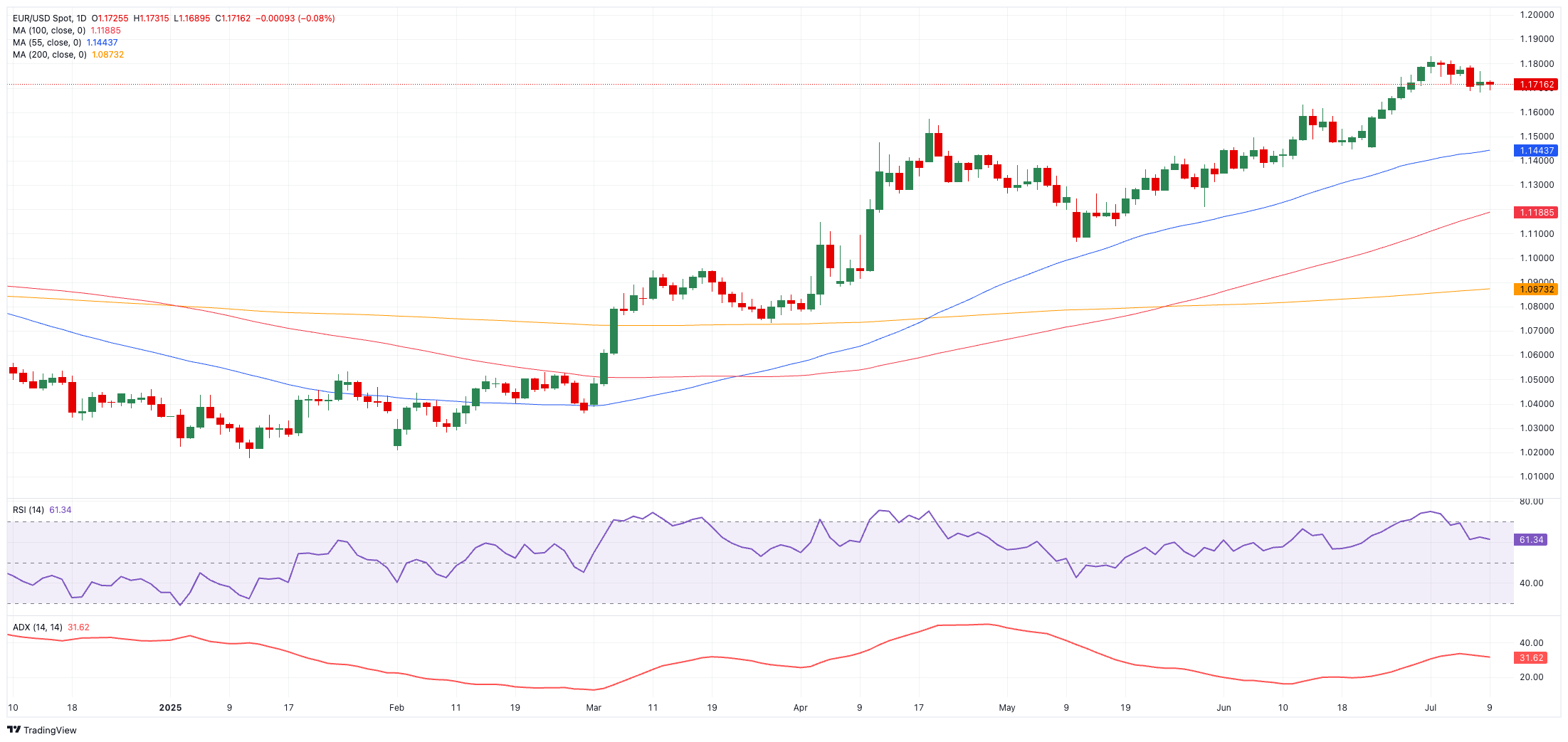
- EUR/USD added to the ongoing bearish tone, meeting contention around 1.1680.
- The US Dollar maintained its resilience amid rising effervescence on the trade front.
- A lack of conviction for a rate cut this month was evident in the FOMC Minutes.
The Euro (EUR) receded marginally against the US Dollar (USD) on Wednesday, with EUR/USD maintaining an erratic performance around the 1.1700 region. After slipping to the area of two-week lows in the 1.1690-1.1680 range, the pair recovered momentum and reclaimed the 1.1700 level later in the day.
Geopolitics and trade unease keep investors wary
The Middle East ceasefire brokered by President Trump in late June briefly supported the risk-sensitive assets by boosting market sentiment. However, that tailwind faded as renewed trade concerns resurfaced.
The White House’s announcement on Monday of 25% tariffs on Japanese and South Korean goods and 50% levies on copper imports, despite delaying the next tariff deadline to August 1, reignited fears of a broader trade conflict and bolstered the US Dollar.
Investors remained cautious about a potential US–EU trade agreement. Despite both sides emphasising the need for a deal, there has been no significant progress.
Policy divergence on hold for now
The Federal Reserve (Fed) held interest rates at 4.25%–4.50% in June, revised up its inflation and employment forecasts, and signalled around 50 basis points of rate cuts by year-end.
During that meeting, a minority of officials expressed support for a rate cut as soon as July, according to Wednesday’s FOMC Minutes. The majority, however, voiced apprehensions regarding the inflationary risks posed by President Trump’s tariffs. Despite differing opinions, a consensus emerged among the majority that rate cuts are likely to be warranted later in the year, with many perceiving any inflationary effects stemming from trade measures as either temporary or constrained.
In contrast, the European Central Bank (ECB) lowered its deposit rate to 2.00% earlier in June. President Lagarde noted that further easing would depend on a clear deterioration in external demand.
Speculative positioning still bullish on EUR
Net speculative long positions in the euro have eased slightly, standing at roughly 107.5K contracts. Meanwhile, commercial players—mainly hedge funds—have pared back their net shorts to 160.6K contracts. Open interest rose to a three-week high, reaching 779K contracts.
Key data ahead
Markets will turn their attention to eurozone data later this week, including the final June Inflation Rate on July 10, followed by EMU Current Account figures and Germany’s Wholesale Prices on July 11.
Technical outlook
Initial resistance stands at the 2025 high of 1.1830 (July 1), followed by the September 2018 peak at 1.1815 (September 24) and the June 2018 high of 1.1852 (June 14).
On the downside, intermediate support lies at the 55-day SMA at 1.1441, followed by the weekly low at 1.1210 (May 29) and the May floor at 1.1064 (May 12), before the psychologically important 1.1000 mark.
Momentum indicators remain constructive: the Relative Strength Index (RSI), near 62, signals bullish conditions, while the Average Directional Index (ADX) around 32 points to a strengthening trend.
EUR/USD daily chart

Medium-term outlook
Barring a fresh geopolitical or macroeconomic shock, EUR/USD appears poised to resume its uptrend, underpinned by easing risk aversion and the outlook for Fed rate cuts later in the year. That said, ongoing trade tensions and President Trump’s unpredictable tariff policy could limit upside in the months ahead.
Employment FAQs
Labor market conditions are a key element to assess the health of an economy and thus a key driver for currency valuation. High employment, or low unemployment, has positive implications for consumer spending and thus economic growth, boosting the value of the local currency. Moreover, a very tight labor market – a situation in which there is a shortage of workers to fill open positions – can also have implications on inflation levels and thus monetary policy as low labor supply and high demand leads to higher wages.
The pace at which salaries are growing in an economy is key for policymakers. High wage growth means that households have more money to spend, usually leading to price increases in consumer goods. In contrast to more volatile sources of inflation such as energy prices, wage growth is seen as a key component of underlying and persisting inflation as salary increases are unlikely to be undone. Central banks around the world pay close attention to wage growth data when deciding on monetary policy.
The weight that each central bank assigns to labor market conditions depends on its objectives. Some central banks explicitly have mandates related to the labor market beyond controlling inflation levels. The US Federal Reserve (Fed), for example, has the dual mandate of promoting maximum employment and stable prices. Meanwhile, the European Central Bank’s (ECB) sole mandate is to keep inflation under control. Still, and despite whatever mandates they have, labor market conditions are an important factor for policymakers given its significance as a gauge of the health of the economy and their direct relationship to inflation.
Information on these pages contains forward-looking statements that involve risks and uncertainties. Markets and instruments profiled on this page are for informational purposes only and should not in any way come across as a recommendation to buy or sell in these assets. You should do your own thorough research before making any investment decisions. FXStreet does not in any way guarantee that this information is free from mistakes, errors, or material misstatements. It also does not guarantee that this information is of a timely nature. Investing in Open Markets involves a great deal of risk, including the loss of all or a portion of your investment, as well as emotional distress. All risks, losses and costs associated with investing, including total loss of principal, are your responsibility. The views and opinions expressed in this article are those of the authors and do not necessarily reflect the official policy or position of FXStreet nor its advertisers. The author will not be held responsible for information that is found at the end of links posted on this page.
If not otherwise explicitly mentioned in the body of the article, at the time of writing, the author has no position in any stock mentioned in this article and no business relationship with any company mentioned. The author has not received compensation for writing this article, other than from FXStreet.
FXStreet and the author do not provide personalized recommendations. The author makes no representations as to the accuracy, completeness, or suitability of this information. FXStreet and the author will not be liable for any errors, omissions or any losses, injuries or damages arising from this information and its display or use. Errors and omissions excepted.
The author and FXStreet are not registered investment advisors and nothing in this article is intended to be investment advice.








